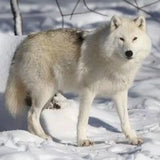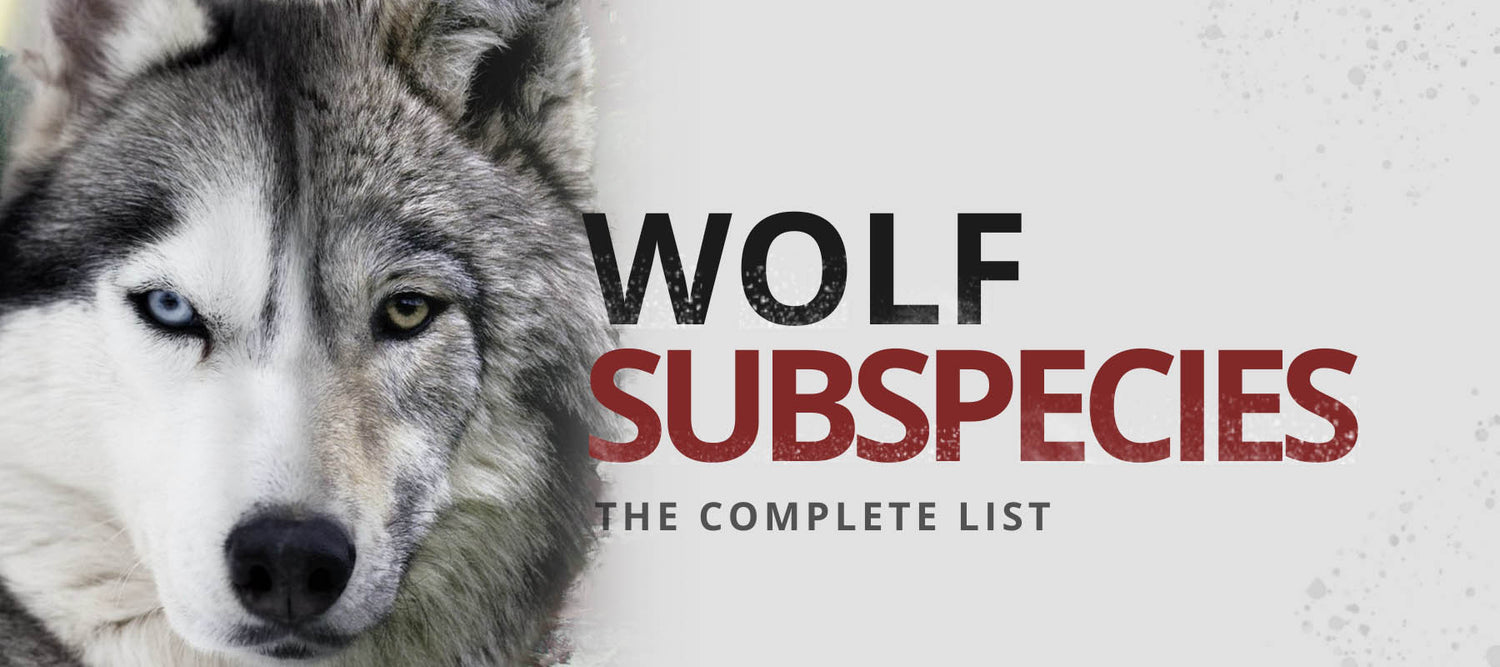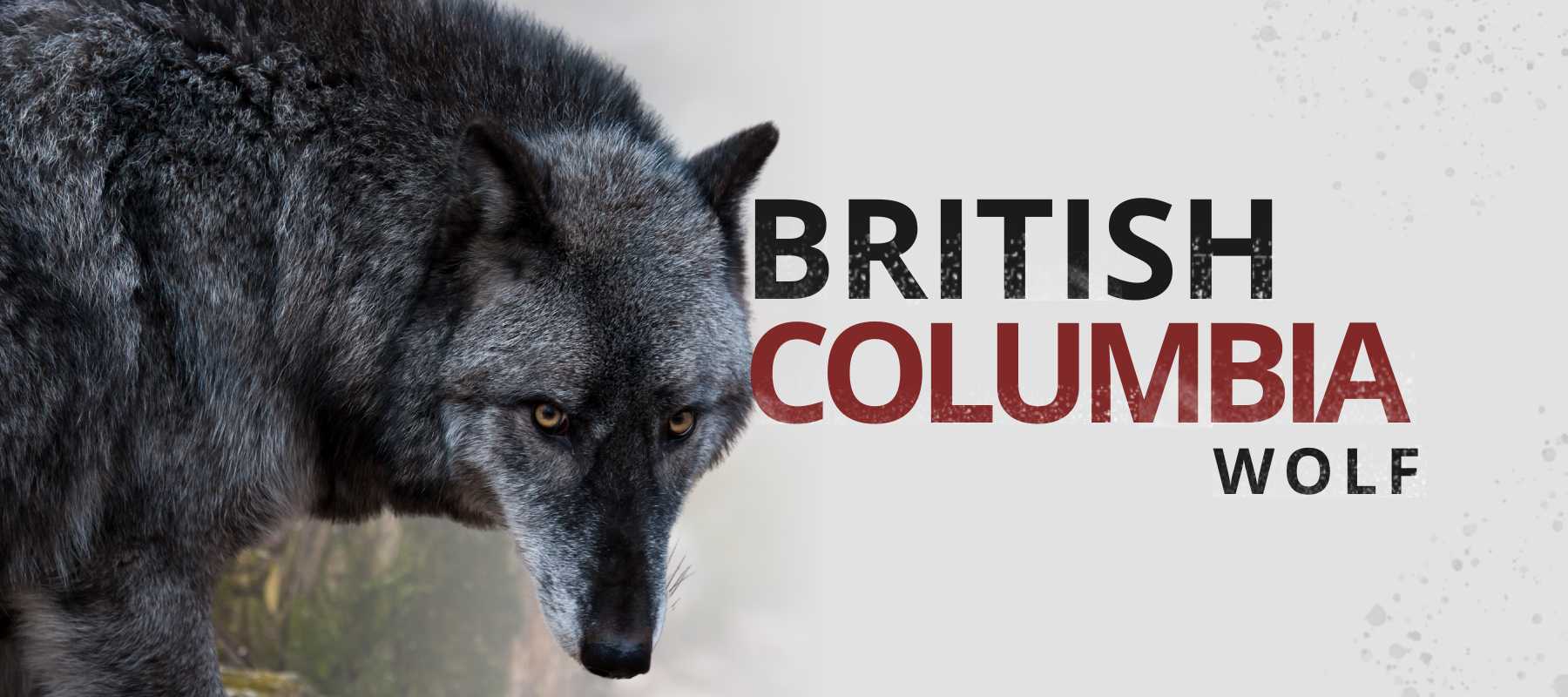The wolf is a carnivorous mammal that is often considered to be a distant relative of the domestic dog (Canis Lupus familiaris), despite their obvious differences in size and behavioral themes.
Did you know that there are different breeds of wolves, each with their own characteristics? These species are distributed in different parts of the world, the majority of them occupying the top step on the food chain of the animal kingdom. If you want to know everything about the different species of wolves that exist, you've come to the right place!
WHAT IS A CANIDAE?
First of all, it is important to understand that the wolf belongs to the large family of canids, which itself is divided into subspecies of which wolves are a part.
Canids are a family of carnivorous mammals with non-retractile claws. They are divided into 12 genera, 23 species and 4 subspecies for the genus Canis. They all have a pointed snout and long canines. They are found on all continents of the planet except Antarctica, in the most diverse environments from the far north to arid areas, and at various altitudes. They demonstrate a great capacity for adaptation.
HOW MANY SPECIES OF WOLF ARE THERE?
The wolf belongs to the canid family of the genus Canis. There are 3 species of wolves: the Grey wolf (Canis lupus), the Red wolf (Canis rufus) and the Abyssinian wolf (Canis simensis).
HOW MANY SUBSPECIES OF WOLF ARE THERE?
Canis Lupus family composed of 38 different subspecies, among them is the cross between the domestic dog and the grey wolf.
WOLF SPECIES LIST
EURASIAN SUBSPECIES OF CANIS LUPUS
| Scientific name | Subspecies | Photos |
|---|---|---|
| Canis Lupus Albus | Tundra wolf |
 |
| Canis Lupus Arabs | Arabian wolf |
 |
| Canis Lupus Campestris | Steppe wolf |
 |
| Canis Lupus Chanco | Mongolian wolf |
 |
| Canis Lupus Dingo | Dingo |
 |
| Canis Lupus Familiaris | Domestic dog |
 |
| Canis Lupus Filchneri | Himalayan wolf |
 |
| Canis Lupus Lupus | Eurasian wolf |
 |
| Canis Lupus Pallipes | Indian wolf |
 |
TUNDRA WOLF (CANIS LUPUS ALBUS)
Among the types of wolves that live in cold areas, there is the Canis lupus albus, popularly known as the Tundra wolf or Siberian wolf. It mainly lives in the Russian tundra and the Siberian region until it reaches Scandinavia. It weighs between 88 and 110 lbs and its fur is long and thick and allows it to survive in extremely cold temperatures.
The Tundra wolf feeds on reindeer, hares and arctic foxes. In addition, it is a nomadic species that travels following the migrations of the animals that form part of its diet.
ARABIAN WOLF (CANIS LUPUS ARABS)
Another breed of wolf is the Arabian wolf (Canis lupus arabs), a subspecies of the grey wolf found in the Sinai Peninsula and several Middle Eastern countries. It is a small desert wolf that weighs only 44 lbs and feeds on carrion as well as smaller animals such as hares.
Unlike other wolves, the Arabian wolf does not howl and does not live in packs. Its coat is sepia with brown, two colors that allow it to camouflage itself perfectly in sand and rocky areas.
STEPPE WOLF (CANIS LUPUS CAMPRESTRIS)
The steppe wolf (Canis lupus campestris) is a subspecies of the grey wolf that lives in the steppes and deserts of Russia, the Caucasus and Central Asia. Also known as the Caspian Sea wolf, it is relatively smaller than its congener the common grey wolf, and its fur is denser, thinner and shorter.
It is considered to be a single subspecies with the Caucasian wolf (Canis lupus cubanensis) and the desert wolf (Canis lupus desertorum).
TIBETAN WOLF (CANIS LUPUS CHANCO)
The Tibetan wolf (Canis lupus chanco), or Mongolian wolf, lives in Mongolia, northern and central China, and Korea. It is also found in the region of Oussouri in Russia, which it is said to have conquered from China, fleeing humans and taking advantage of the disappearance of the other great predator of the region, the tiger.
In Mongolia, the wolf permeates legends and is considered a totem animal. For wolf, Mongolians say "chono". A separate subspecies of the Mongolian wolf has been proposed and then rejected for individuals living in Korea (Canis lupus coreanus), which has a finer snout.
DINGO (CANIS LUPUS DINGO)
The dingo (Canis lupus dingo) is a variety distributed in Australia and some Asian areas. It is a small wolf that weighs only 70,5 lbs, which is why it is considered a dog and is even adopted as a pet.
The dingo's coat has a uniform color that varies between red and yellow; there are even specimens with albinism.
DOG (CANIS LUPUS FAMILIARIS)
The domestic dog (Canis lupus familiaris) is one of the most widespread animals in the world and is a favourite pet of many families. Its physical characteristics vary between the different recognized breeds that exist, with wide differences in size, color, coat type, personality and life expectancy.
The domestic dog is a different subspecies. Originally, the most recent theories suggest that the dog as we know it today is the result of crossbreeding between dingo wolves, basenji wolves and jackals. However, 14,900 years ago the lines of dogs and wolves separated, although they shared common ancestors. From this separation, each species developed differently and the dog was eventually domesticated.
HIMALAYAN WOLF (CANIS HIMALAYENSIS)
The Himalayan wolf (Canis himalayensis) is native to Nepal as well as northern India. They live in small communities and nowadays there are only a small number of adult specimens.
As for its appearance, it is a very fine little wolf. Its coat is hard and it comes in light brown, grey and cream colors.
EURASIAN WOLF (CANIS LUPUS LUPUS)
Canis lupus lupus is the most extensive subspecies of grey wolf that exists. This type of wolf inhabits a large part of Europe, as well as large Asian territories, such as China. Among the European species, it is one of the largest, weighing between 88 and 154 lbs. Its fur is gray and its abdomen is cream-colored.
As for its diet, the common gray wolf is a predator of hares, cattle, elk, deer, goats and wild boar.
INDIAN WOLF (CANIS LUPUS PALLIPES)
The Indian wolf (Canis Lupus Pallipes) is native to Israel, Saudi Arabia, India and Pakistan, where it prefers to live in semi-desert areas. It is a wolf with a stylized body, which weighs only 66 lbs, its fur is reddish or tiger and it allows them to camouflage themselves in sand and rocky areas.
This breed of wolf feeds mainly on cattle, which is why it was persecuted in India for several centuries.
North American subspecies of Canis lupus
| Scientific name | Subspecies | Photos |
|---|---|---|
| Canis Lupus Arctic | Arctic wolf |
 |
| Canis Lupus Baileyi | Mexican wolf |
 |
| Canis Lupus Columbianus | British Columbian wolf |
 |
| Canis Lupus Crassodon | Vancouver Island wolf |
 |
| Canis Lupus Hudsonicus | Hudson Bay wolf |
 |
| Canis Lupus Irremotus | Northern Rocky Mountain wolf |
 |
| Canis Lupus Labradorius | Labrador wolf |
 |
| Canis Lupus Ligoni | Alexander Archipelago wolf |
 |
| Canis Lupus Lycaon | Eastern wolf |
 |
| Canis Lupus Mackenzie | Mackenzie River wolf |
 |
| Canis Lupus Manningi | Baffin Island wolf |
 |
| Canis Lupus Occidentalis | Northwestern wolf |
 |
| Canis Lupus Orion | Greenland wolf |
 |
| Canis Lupus Pambasileus | Alaskan Interior wolf |
 |
| Canis Lupus Rufus | Red wolf |
 |
| Canis Lupus Tundrarum | Alaskan Tundra wolf |
 |
ARCTIC WOLF (CANIS LUPUS ARCTOS)
Canus lupus arctos, or Arctic wolf, is an endemic specimen of Canada and Greenland. Its size is smaller than that of other wolves and it weighs around 99 lbs. As a form of adaptation to its icy environment where it lives, it has a white or light yellow fur that allows it to camouflage itself perfectly. It is also a subspecies of Canis Lupus.
This species tends to live in rock caves and it feeds on other mammals that live in arctic areas, such as elk, beef and caribou, as well as seals and partridges.
MEXICAN WOLF (CANIS LUPUS BALEYI)
Another breed of wolf is the Canis lupus baileyi, a subspecies that lives in North America, where it prefers to live in deserts and temperate forest zones. The mexican wolf weighs up to 99 lbs and its fur is of several colors, among which are cream, yellow and black.
This species feeds on cattle, hares, sheep and rodents. Due to the fact that it attacks cattle, it was hunted and nowadays it is considered extinct in the wild, however, there are some programs for its reproduction in captivity.
BRITISH COLUMBIAN WOLF (CANIS LUPUS COLUMBIANUS)
The British Columbia wolf was classified as subspecies Canis lupus columbianus in 1941 by senior biologist Edward Goldman.
It was once found in most of British Columbia, parts of the Yukon, Alberta and southwestern Alaska. It has crossed territories with the Alexander Archipelago Wolf and the Cascade Mountain Wolf.
Canis lupus columbianus was one of the largest subspecies of grey wolves in North America. They weighed between 36 and 68 kg, and had long hairs that were usually black, often mixed with grey or brown. They were about 1.52 to 1.78 m long.
VANCOUVER WOLF (CANIS LUPUS CRASSODON)
The Vancouver Island wolf, or, Canis lupus crassodon is endemic to Vancouver Island in Canada. Like the arctic wolf, it has a white coat that allows it to camouflage itself in its environment. Although not much is known about this type of wolf, it is known to live in packs of up to 35 individuals and rarely approaches areas populated by humans.
HUDSON BAY WOLF (CANIS LUPUS HUDSONICUS)
The Hudson Bay Wolf (Canis Lupus Hudsonicus) was classified as a subspecies of the Grey Wolf in 1941 by senior biologist Edward A. Goldman. It is compared to the Tundra Wolf.
It lives in the far northwestern United States and western Canada, just above Hudson Bay. Most individuals have a white fur, but grey specimens can be found in the wild. It is one of the only wolves that migrates in winter, following the local caribou populations.
NORTHERN ROCKY MOUNTAIN WOLF (CANIS LUPUS IRREMOTUS)
The Northern Rock Wolf (Canis Lupus Irremotus) was classified as a subspecies of the Grey Wolf in 1937 by senior biologist Edward A. Goldman.
It lives in the Rocky Mountains north of Alberta, Canada. The Northern Rocky Mountain Wolf is cream-coloured, light brown and medium in size.
LABRADOR WOLF (CANIS LUPUS LABRADORIUS)
The Labrador wolf (Canis lupus labradorius) was identified as a subspecies of the grey wolf by biologist Edward A. Goldman in 1937. Labrador wolves are rarely photographed in the wild. It is a rare and endangered species.
They still inhabit most of their historic range in Labrador and northern Quebec. They are medium-sized wolves with dark grey to almost white fur.
ALEXANDER ARCHIPELAGO WOLF (CANIS LUPUS LIGONI)
The Alexander Archipelago wolf, also known as Canis lupus ligoni, is found on the southeast coast of Alaska. A large part of them reside in the Tongass National Forest in Alaska. They can be found on the mainland from the entrance of Dixon to Yakutat Bay, and on all the main islands of the Alexander Archipelago, except Admiralty, Baranof and Chichagof.
These wolves have short hairs, usually black or of a rather dark color. On average they are about 1 meter long, 61 cm high, and weigh between 13.5 kg and 22.5 kg. Taxonomist Goldman described the Alexander Archipelago wolf as being smaller and having shorter and darker hair than wolves in the northern and interior regions of Alaska.
EASTERN WOLF (CANIS LYCAON)
The eastern wolf (Canis lycaon), which inhabits the southeastern Canadian area was considered to be a subspecies of the grey wolf (canis lupus), however, in 2003, it was finally declared as a wolf species in its own right.
This breed of wolf inhabits the mouthful areas of Canada, where it feeds on smaller vertebrates and lives in packs. It has a hard and long fur of black and light cream colors. It is also an endangered species due to the destruction of their habitat and the fragmentation of the populations that this has caused within its packs.
MACKENZIE RIVER WOLF (CANIS LUPUS MACKENZII)
Originally identified as subspecies Canis lupus mackenzii in 1943 by Canadian zoologist Rudolph Anderson, the Mackenzie River Wolf was reclassified in 1992 as a member of the subspecies Canis lupus occidentalis.
They are tall and measure about 80 cm at the withers with a large head and a large forehead. Coming from the north, they have wide foot soles adapted to travel on snow. Their ears are short to reduce heat loss.
BAFFIN ISLAND WOLF (CANIS LUPUS MANNINGI)
The Baffin Island wolf (Canis lupus manningi) is a rare subspecies that lives alone on Baffin Island, Canada. Its fur and size are similar to that of the Arctic wolf. Not much is known about this species, but it is known to feed on hares and foxes.
NORTHWESTERN WOLF (CANIS LUPUS OCCIDENTALIS)
The Northwestern wolf (Canis lupus occidentalis) inhabits the coasts from the icy Arctic Ocean to the United States. It is one of the largest wolves that can measure up to 85 centimetres long, even though it weighs only between 99 and 110 lbs.
As for its fur, it can be black, gray or brown with white. Its diet is varied, it can feed on oxen, hares, reptiles, deer and elk.
GREENLAND WOLF (CANIS LUPUS ORION)
The Greenland wolf (Canis Lupus Orion) has been described as a white wolf similar to the Arctic wolf and resident in Greenland. It was classified as a distinct subspecies in 1935 by British zoologist Reginald Innes Pocock.
Unfortunately, there is no evidence that the Greenland wolf has ever existed or still exists. It would appear that the Greenland wolves were migrants from Canada.
YUKON WOLF (CANIS LUPUS PAMBASILEUS)
Another breed of wolf is the Canis lupus pambasileus also known as the Yukon wolf. It lives in the Yukon, a territory of Canada, from where it takes its name. With a maximum weight of 70 lbs, it is one of the largest wolves in the world.
Its fur combines different colors between white, grey, beige and black, colors that are randomly distributed on its body.
RED WOLF (CANIS RUFUS)
Leaving aside the subspecies of grey wolf, within the wolf species we also find the Canis rufus also known as the red wolf. It inhabits some areas of Mexico, the United States and Canada. Unfortunately, it is in critical danger of extinction due to the hunting of the species it feeds on, the introduction of specimens into its environment and the effect of the construction of transportation routes.
EXTINCTED SUBSPECIES OF CANIS LUPUS
| Scientific name | Subspecies | Photos |
|---|---|---|
|
Canis Lupus Alces |
Kenai Peninsula wolf |
|
|
Canis Lupus Beothucus |
Newfoundland wolf |
 |
|
Canis Lupus Bernardi |
Bernard's wolf (Banks Island wolf) |
|
|
Canis Lupus Floridanus |
Florida Black wolf |
 |
|
Canis Lupus Fuscus |
Cascad Mountains wolf |
|
|
Canis Lupus Gregoryi |
Mississippi Valley wolf |
 |
|
Canis Lupus Griseoalbus |
Manitoba wolf |
 |
|
Canis Lupus Hattai |
Hokkaido wolf |
 |
|
Canis Lupus Hodophilax |
Honshu wolf |
 |
|
Canis Lupus Mogollonensis |
Mongollon Mountain wolf |
|
|
Canis Lupus Monstrabilis |
Texas wolf |
|
|
Canis Lupus Nubilus |
Great Plains wolf |
 |
|
Canis Lupus Youngi |
Southern Rocky Mountain wolf |
|
|
Canis Lupus Cristaldii |
Sicilian wolf |
 |
KENAI PENINSULA WOLF (CANIS LUPUS ALCES) †
The wolf of the Kenai Peninsula was the largest wolf in North America before men exterminated it. It was identified as a subspecies Canis lupus alces in 1941 by senior biologist Edward Goldman based on skeletal findings.
He lived on the Kenai Peninsula and adjacent areas in Alaska and fed mostly on elk, hence the name Canis lupus alces.
NEWFOUNDLAND WOLF (CANIS LUPUS BEOTHUCUS) †
The Newfoundland wolf subspecies (Canis lupus beothucus) was not officially described until 1937 by zooligists G.M. Allen and Thomas Barbour, after it had already been threatened with extinction. Its scientific name Canis lupus beothucus comes from the Beothuck, the native Newfoundlanders who were officially declared extinct in 1829.
The Newfoundland wolf lived on the island of Newfoundland off the east coast of Canada. Recent evidence has suggested that the first wolves to inhabit the island may have been there before the last ice age, surviving the ice age in refuges south of the ice cap.
BERNARD'S WOLF (CANIS LUPUS BERNARDI) †
The Bernard's wolf resided on the Isle of Banks in Canada's Northwest Territories. It used to exist in the Victoria Archipelago but was eradicated by over-hunting.
It was not until 1943 that zoologist Rudolph Martin Anderson identified the wolf of Bernard also known as the Bank Island wolf as the subspecies Canis lupus bernardi. The skin of an adult male and a skull of the Bernard's wolf had been deposited at the National Museum of Canada by explorer Peter Bernard, and it was decided to name this wolf after him.
FLORIDA BLACK WOLF (CANIS LUPUS FLORIDANUS) †
This canid was officially declared extinct in 1921, although it has not been seen in the wild since 1908. Its status was long controversial, as it was once considered a subspecies of the red wolf. The Florida black wolf is also known as the Florida wolf or Canis lupus floridanus.
CASCADE MOUNTAINS WOLF (CANIS LUPUS FUSCUS) †
The Cascade Mountain wolf (Canis lupus fuscus) was described by Edward Alphonso Goldman in 1945. Nevertheless, the first description was made earlier by Sir John Richardson in 1839 and is the authoritative description of the current taxonomy. The Cascade wolf is also known as the brown wolf or Oregon wolf.
MISSISSIPPI VALLEY WOLF (CANIS LUPUS GREGORYI) †
The Mississippi Valley Wolf (Canis Lupus gregoryi), also known as Gregory's wolf, is a subspecies of the red wolf described in 1937 by Edward Alphonso Goldman. Its current taxonomy as a subspecies of grey wolf or red wolf is not yet clear, with some authors classifying Gregor's red wolf as either species.
MANITOBA WOLF (CANIS LUPUS GRISEOALBUS) †
The Manitoba wolf, also known as the Saskatchewan wolf or canis lupus griseoalbus, is one of the subspecies of canis lupus. It was described by zoologist Spencer Baird in 1858. Although the Manitoba wolf is officially classified as a subspecies, many specialists do not recognize it as such, including it with the Hudson Bay wolf.
There is no reliable information on the status of the populations, for which reason it has been declared an extinct species.
HOKKAIDO WOLF (CANIS LUPUS HATTAI) †
The Hokkaido wolf or Canis lupus hattai, formerly known as Canis lupus rex, was also known as the Ezo wolf or Ezoookami. It was classified as a subspecies of the gray wolf in 1931 by the Japanese arachnologist Kyukichi Kishida. Hokkaido wolves are descendants of the continental Siberian wolves.
They once inhabited the Japanese island of Hokkaido, the Russian island of Sakhalin and the Kamchatka Peninsula, and the Kuril Islands.
Compared to the Honshu wolf, the Hokkaido wolf is closer to the standard gray wolf in terms of size, dimensions and other characteristics. They were generally light gray or tanned gray in color.
HONSHU WOLF (CANIS LUPUS HODOPHILAX) †
Identified in 1839 as a subspecies of the grey wolf by the Dutch zoologist Coenraad Temminck. The Honshu wolf (Canis lupus hodophilax), like its cousin from the island of Hokkaido, has totally disappeared from the wilderness of Japan. It was declared officially extinct in 1905, when the last specimen was shot.
MOGOLLON MOUNTAIN WOLF (CANIS LUPUS MOGOLONENSIS) †
The Mongollon mountain wolf was classified as a subspecies of the gray wolf Canis lupus mongolonensis by biologist Edward A. Goldman in 1937. Its name was given to it by the Mogollon Mountain Indians in Arizona and New Mexico.
He lived in the Mogollon Mountains region of central Arizona and in the southeast and Sacramento (central) mountains of New Mexico.
TEXAS WOLF (CANIS LUPUS MONSTRABILIS) †
Described in 1937 by the biologist Edward Alphonso Goldman, this canid died five years later in 1942 and was posthumously merged by some authors with the Mexican wolf. Today, the Texas wolf (canis lupus monstrabilis) is recognized as a distinct subspecies but its status is not unanimous.
SOUTHERN ROCKY MOUNTAIN WOLF (CANIS LUPUS YOUNGI) †
While still alive, the southern rock wolf (canis lupus youngi) occupied the regions of Nevada, Arizona, Utah and Colorado. Its main habitat included coniferous and deciduous forests and adjacent grasslands.
As a result of hunting, trapping and poisoning campaigns aimed at eradicating wolves from the wild, the southern rock wolf eventually became extinct. It was officially declared extinct in 1935.





